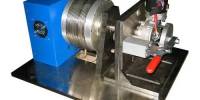A solar tracker is a device that points a payload in the direction of the Sun. Payloads are typically solar panels, parabolic troughs, fresnel reflectors, lenses, or heliostat mirrors. It is a device that tracks the Sun’s movement throughout the day in order to maximize the efficiency of solar energy systems such as solar panels or concentrated solar power (CSP) plants. A solar tracker’s primary function is to orient solar panels or mirrors so that they receive the most sunlight possible at any given time.
Trackers are used in flat-panel photovoltaic systems to minimize the angle of incidence between incoming sunlight and a photovoltaic panel, also known as the cosine error. When this angle is reduced, the amount of energy produced from a fixed amount of installed power-generating capacity increases. Trackers were predicted to be used in at least 85% of commercial installations greater than one megawatt from 2009 to 2012 in standard photovoltaic applications from 2008-2009.
There are two main types of solar trackers:
- Single-axis trackers: These trackers rotate the solar panels or mirrors on a single axis, typically from east to west, to track the Sun’s daily movement from sunrise to sunset. Depending on the latitude and desired tilt angle for optimizing solar exposure, single-axis trackers can be horizontal or tilted.
- Dual-axis trackers: These trackers move the solar panels or mirrors on two axes, allowing them to track the Sun’s daily and seasonal movements. Dual-axis trackers can adjust the tilt angle and rotation at the same time, resulting in the highest energy yield possible throughout the year. They are usually more complicated and costly than single-axis trackers.
Single-axis trackers have been installed in an increasing number of utility-scale projects as their pricing, reliability, and performance have improved. According to WoodMackenzie/GTM Research data, global solar tracker shipments reached a new high of 14.5 gigatonnes in 2017. This represents a 32% year-on-year increase, with similar or greater growth expected as large-scale solar deployment accelerates.
Solar trackers use various methods to track the Sun’s position. Some common tracking mechanisms include:
- Light sensors: These sensors detect the intensity of sunlight and adjust the orientation of the solar panels accordingly.
- GPS-based trackers: These trackers use GPS (Global Positioning System) technology to determine the exact location and movement of the Sun.
- Timers and algorithms: Solar trackers can also rely on pre-programmed timers and algorithms to calculate the Sun’s position based on time, date, and geographical coordinates.
Increased energy production, improved efficiency, and a higher return on investment for solar energy systems are all advantages of using solar trackers. Solar trackers can optimise the amount of sunlight captured by continuously adjusting the orientation of solar panels or mirrors, resulting in a significant increase in energy output compared to fixed-mounted systems.















